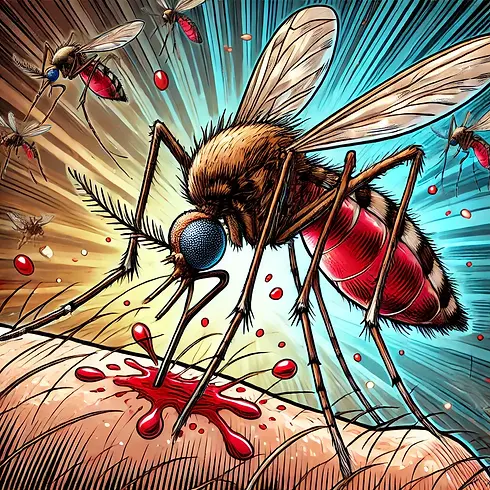at the University of Toronto
OUR CURRENT RESEARCH PROJECTS

PEXIL™ Technology
The world is in desperate need of new drugs to combat drug-resistant pathogens, parasites and crop pests. To help accelerate drug discovery, Peter’s group has recently developed a new, high-throughput, massively paralleled drug/pesticide screening technology called PEXIL™. PEXIL’s advantages over traditional phenotypic screens using single pathogens or agricultural pests include: i) targeting of 100s of pathogens or pests simultaneously; ii) the delivery of new targets that enable medicinal chemistry optimization of new small molecule leads, and, iii) the ability to target pathogens and pests that are simply unscreenable in high-throughput fashion (i.e. schistosomes, cestodes, insects, plant parasitic nematodes etc).

Towards a Novel High-Throughput Pharmacogenomics Assay
There are 100s of different protein-changing polymorphisms between any two random people. Often, these differences contribute to critical variation in how people respond to different drugs. Some may metabolize one drug faster than average, leading to ineffective outcomes. Others may metabolize the same drug slower than average, leading to a dangerous levels of drug accumulation within the body.
We are developing a novel assay to probe how well drug-detoxifying enzymes work. For each drug-detoxifying enzyme of interest, we will create a massive collection of mutations in that enzyme. We will systematically mutate every residue to all 19 other residues and use our massively high-throughput assay to determine which mutations change the rate at which the enzyme can detoxify a given drug. In this way, we will be able to predict how a person’s polymorphisms in a given drug-detoxifying enzyme will impact their ability to metabolize that drug.

Novel Approaches to Control Mosquitos that Transmit Disease
Mosquitoes are the deadliest animal in the world and kill over 700,000 people annually through their transmission of malaria, Dengue virus, Zika virus, West Nile virus, and yellow fever virus. Insecticides have played an important role in reducing the burden of mosquito-borne diseases but mosquitoes like Anopheles gambiae and Aedes aegypti have evolved resistance to many of these compounds. In 2023, the WHO reported resistance to at least one insecticide class in at least one mosquito species in 88.6% of malaria endemic countries. Alarmingly, this includes resistance to pyrethroids, the primary insecticide used in insecticide-treated bed netting. In this project we have taken a new approach to turn the mechanism of insecticide resistance against the mosquito.

A Novel High-Throughput Discovery Pipeline for Amyloid Inhibitors
Over 50 human diseases are thought to have amyloid formation as their root cause. These include Parkinson’s, ALS, scrapie, Huntington’s, and perhaps Alzheimer’s to name but a few. The Roy Lab has previously found that select small molecules crystallize in association with the nematode’s pharynx cuticle (see their Kamal et al., 2019, 2022, and 2023 paper for details). Peter’s group recently made the fortuitous discovery that an astonishing 47% of compounds that inhibit crystal formation can also inhibit amyloid formation. This hit rate is vastly superior to other screens for amyloid inhibitors, which achieve a hit rate of 0.4% or less. Hence, screens for molecules that disrupt crystal formation may yield novel amyloid-busters. You can read the pre-print of the manuscript describing this work here.

Multiple Discovery Pipelines Reveal Candidate Anti-Parasitic Compounds
The Roy Lab has developed a drug-screening pipeline that reveals small molecule disruptors of motor behaviour in nematodes. Nementin™ is one scaffold revealed by this screen. Nementin™ induces convulsions, paralysis and death though massive neurotransmitter release. Nementin™ also dramatically enhances the activity of organophosphate and carbamate pesticides that are used kill parasitic nematodes. Hence, Nementin™ may have utility in reducing the amount of these non-specific pesticides that are used in agriculture. Read about Nementin™ here.
Nemacol™ is a second anti-parasitic nematicidal molecule that was revealed by this pipeline. Nemacol™ inhibits the vesicular acetylcholine transporter (VAChT) and holds potential to be developed into a useful anti-parasitic compound. Read about Nemacol™ here.
Through a different pipeline, we have discovered several cytochrome P450 bioactivated pro-nematicides. These compounds are inert until they are metabolized selectively by nematode cytochrome P450s. Two of these molecules include Selectivin™ and Cyprocide™, which can be read about here and here, respectively. Each of these molecules have good potential to control plant parasitic nematodes, which are estimated to destroy over $150B USD worth of crop every year.

Towards Protection Against
the Side Effects of CAD Drugs
100,000s of individuals experience a drug-induced accumulation of toxic fats in the liver and other cells called phospholipidosis (PLD). In 5-10% of afflicted individuals, PLD culminates in death or necessities a liver transplantation. A major contributor to PLD is Cationic Amphiphilic Drugs (CADs), which comprise ~20% of clinically used small molecule drugs. Beyond modulating their therapeutic target, CADs will accumulate in the lysosome and disrupt its ability to break down lipids.
Through genetic analyses, we have discovered a robust CAD defense system in the small animal model C. elegans, which is a free-living nematode worm. In this project, we are using LCMS and other tools to understand how animals detect and defend against CADs. We are also doing screens for drugs that can suppress the effects CADs in the hopes that these compounds will be useful in the clinic to combat the potentially lethal CAD side effects.
